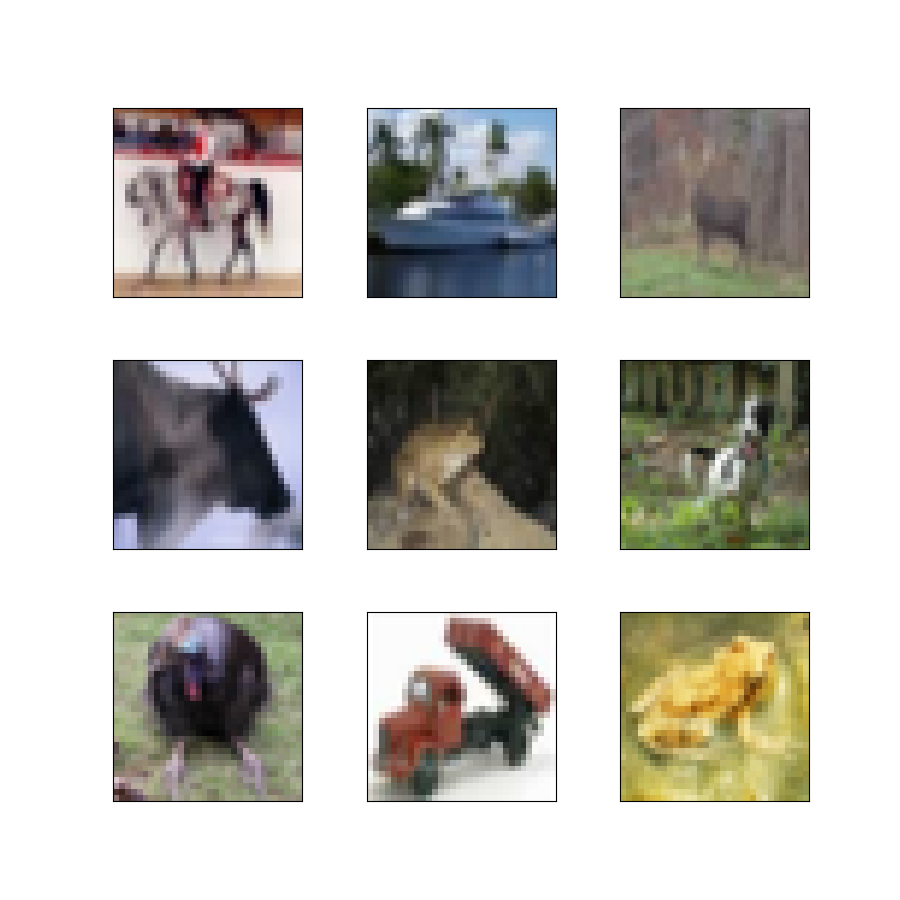- विवरण :
वास्तविक मानव एनोटेशन त्रुटियों के साथ CIFAR-10 का पुनः लेबल किया गया संस्करण। मूल CIFAR-10 ट्रेन सेट में प्रत्येक जोड़ी (छवि, लेबल) के लिए, यह वास्तविक मानव एनोटेटर द्वारा दिए गए कई अतिरिक्त लेबल प्रदान करता है।
स्रोत कोड :
tfds.image_classification.cifar10_n.Cifar10Nसंस्करण :
-
1.0.0: प्रारंभिक रिलीज। -
1.0.1:worse_labelकुंजी में निश्चित टाइपो। -
1.0.2: एनोटेशन और छवियों के बीच निश्चित पत्राचार। -
1.0.3:MANUAL_DIRमें फिक्स्ड फाइलें। -
1.0.4(डिफ़ॉल्ट): साइड जानकारी की निश्चित लोडिंग।
-
डाउनलोड आकार :
162.17 MiBडेटासेट का आकार :
147.91 MiBमैन्युअल डाउनलोड निर्देश : इस डेटासेट के लिए आपको स्रोत डेटा को मैन्युअल रूप से
download_config.manual_dir(डिफ़ॉल्ट रूप से~/tensorflow_datasets/downloads/manual/) में डाउनलोड करना होगा:
https://github.com/UCSC-REAL/cifar-10-100n से 'side_info_cifar10N.csv', 'CIFAR-10_human_ordered.npy' और 'image_order_c10.npy' डाउनलोड करें
फिर 'CIFAR-10_human_ordered.npy' को CSV फ़ाइल 'CIFAR-10_human_annotations.csv' में बदलें। यह निम्नलिखित कोड के साथ किया जा सकता है:
import numpy as np
from tensorflow_datasets.core.utils.lazy_imports_utils import pandas as pd
from tensorflow_datasets.core.utils.lazy_imports_utils import tensorflow as tf
human_labels_np_path = '<local_path>/CIFAR-10_human_ordered.npy'
human_labels_csv_path = '<local_path>/CIFAR-10_human_annotations.csv'
with tf.io.gfile.GFile(human_labels_np_path, "rb") as f:
human_annotations = np.load(f, allow_pickle=True)
df = pd.DataFrame(human_annotations[()])
with tf.io.gfile.GFile(human_labels_csv_path, "w") as f:
df.to_csv(f, index=False)
ऑटो-कैश्ड ( दस्तावेज़ीकरण ): हाँ
विभाजन :
| विभाजित करना | उदाहरण |
|---|---|
'test' | 10,000 |
'train' | 50,000 |
- फ़ीचर संरचना :
FeaturesDict({
'aggre_label': ClassLabel(shape=(), dtype=int64, num_classes=10),
'id': Text(shape=(), dtype=string),
'image': Image(shape=(32, 32, 3), dtype=uint8),
'label': ClassLabel(shape=(), dtype=int64, num_classes=10),
'random_label1': ClassLabel(shape=(), dtype=int64, num_classes=10),
'random_label2': ClassLabel(shape=(), dtype=int64, num_classes=10),
'random_label3': ClassLabel(shape=(), dtype=int64, num_classes=10),
'worker1_id': int64,
'worker1_time': float32,
'worker2_id': int64,
'worker2_time': float32,
'worker3_id': int64,
'worker3_time': float32,
'worse_label': ClassLabel(shape=(), dtype=int64, num_classes=10),
})
- फ़ीचर दस्तावेज़ीकरण :
| विशेषता | कक्षा | आकार | डीटाइप | विवरण |
|---|---|---|---|---|
| विशेषताएं डिक्ट | ||||
| agre_लेबल | क्लासलेबल | int64 | ||
| पहचान | मूलपाठ | डोरी | ||
| छवि | छवि | (32, 32, 3) | uint8 | |
| लेबल | क्लासलेबल | int64 | ||
| random_label1 | क्लासलेबल | int64 | ||
| random_label2 | क्लासलेबल | int64 | ||
| random_label3 | क्लासलेबल | int64 | ||
| कार्यकर्ता1_आईडी | टेन्सर | int64 | ||
| कार्यकर्ता1_समय | टेन्सर | फ्लोट32 | ||
| कार्यकर्ता2_आईडी | टेन्सर | int64 | ||
| कार्यकर्ता2_समय | टेन्सर | फ्लोट32 | ||
| कार्यकर्ता3_आईडी | टेन्सर | int64 | ||
| कार्यकर्ता3_समय | टेन्सर | फ्लोट32 | ||
| bad_label | क्लासलेबल | int64 |
पर्यवेक्षित कुंजियाँ (
as_superviseddoc देखें):Noneचित्र ( tfds.show_examples ):

- उदाहरण ( tfds.as_dataframe ):
- उद्धरण :
@inproceedings{wei2022learning,
title={Learning with Noisy Labels Revisited: A Study Using Real-World Human
Annotations},
author={Jiaheng Wei and Zhaowei Zhu and Hao Cheng and Tongliang Liu and Gang
Niu and Yang Liu},
booktitle={International Conference on Learning Representations},
year={2022},
url={https://openreview.net/forum?id=TBWA6PLJZQm}
}

